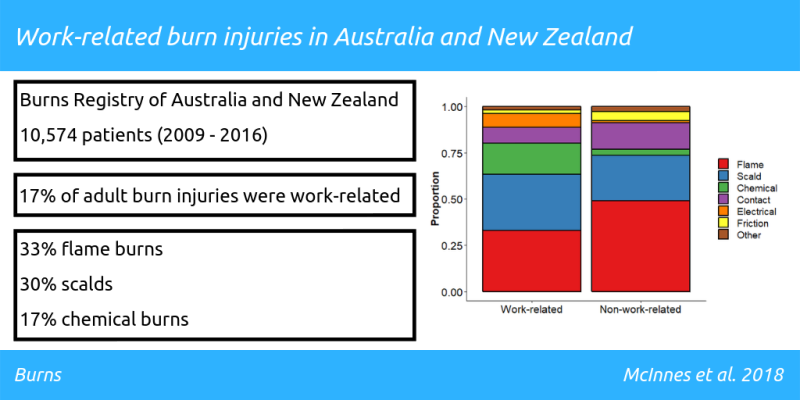Epidemiology of Work-related Burn Injuries
New publication in Burns
Work-related injuries are a significant public health problem. A 2015 report from Safe Work Australia estimates the annual cost of work-related injuries to exceed $60 billion.
Burn injuries are one of the most devastating type of work-related injuries. Burn injury survivors often require prolonged periods of treatment and rehabilitation. These patients also experience many challenges when returning to work.
Despite this, we don’t know how common work-related burn injuries are in Australia and New Zealand.
Judy McInnes, my Monash University colleague, was interested in investigating the characteristics of work-related burn injury cases in Australia and New Zealand. A key part of this study was comparing burn injuries that occurred while people were at work with burn injuries that occurred in a non-work context (e.g., at home).
The Burns Registry of Australia and New Zealand provided data on patients of working age (15-64 years) who sustained a burn injury at work between July 2009 and June 2016 and presented to a specialist burns unit in Australia or New Zealand.
More than 10,000 people of working age presented to a specialist burns unit over the study period. Of these people, just over 17% had a work-related burn injury.

The majority of cases with a burn-related injury were males under the age of 35. Work-related burn injuries were most commonly caused by:
- Sparks or flames from angle grinders and oxyacetylene torches
- Scalds from fat, oil, or hot water from a saucepan, kettle, or jug
- Chemical burns from cleaning products
One particularly interesting finding was that a higher proportion of work-related burn injuries received a burn cooling intervention such as cool running water at the scene of injury compared to non-work-related burns. We believe that worksite occupational health and safety first-aid protocols and training may partly explain this finding.
The findingins from this paper can help inform targeted prevention strategies, workplace education programs, and occupational health and safety policy to minimise work-related burn injuries.
The full text of the article is available online at Burns.